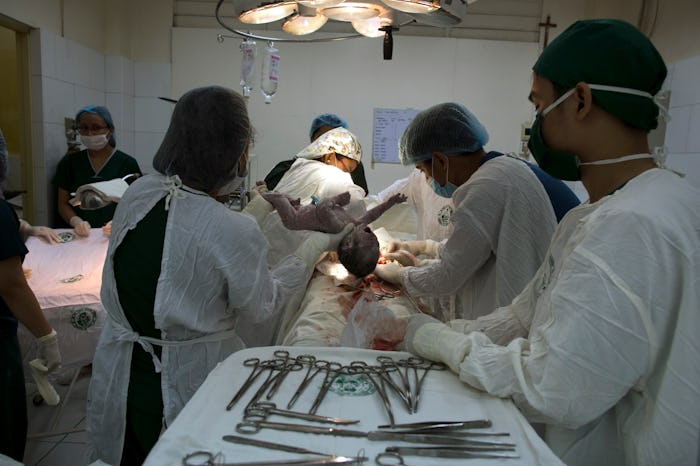Life

Medical Experts On How To Avoid A C-Section
There's nothing inherently wrong with having a C-section instead of a vaginal birth. Lots of women need to deliver this way for lots of different reasons, and it's great that they have the option. But C-sections are considered surgeries, and surgeries come with increased risks. So, many women prefer to have their babies the old-fashioned way whenever it's medically safe to do so. Luckily for them, a new study just shed some light on how to avoid a C-section. And the verdict is that the best ways to do that mirror the genesis of so many other positive health outcomes: healthy eating habits and exercise. Heeding that advice is a good move throughout pregnancy and beyond — an even stronger incentive for expecting moms to get on board.
The incentives for pregnant women to embrace a healthy lifestyle are especially striking to begin with, the meta-analysis, which was published Wednesday in the journal The BMJ, concluded. By analyzing data collected from 12,500 women in 36 previous studies, researchers from the International Weight Management in Pregnancy Collaborative Group found that c-sections were 9 percent less prevalent in women who adhered to such healthy lifestyle guidelines. This helped the women to gain less weight than their counterparts who ate less healthy diets and didn't exercise.
As a result, the babies of the moms with healthier lifestyles were less likely to have a high birth weight and their moms less likely to have preeclampsia — a condition that manifests in high blood pressure — during pregnancy. Both of those factors are reasons why a woman might need a c-section. So, mitigating them at the outset through healthy eating and exercise appears to have mitigated the need for a c-section to some degree.
Still, there are other reasons that a woman might need to have a c-section. According to the March of Dimes, these include having delivered this way in the past, problems with the placenta, infections like HIV or genital herpes, and a chronic health condition (such as diabetes or high blood pressure) in the mom. Mothers of multiples are also likelier candidates for a c-section.
In the absence of these extenuating circumstances, though, the new meta-analysis suggests that staying within a healthy weight-gain range is key for new moms who want to avoid the added risks associated with c-sections. But what, exactly, does that look like? It's important to remember that every pregnancy is unique, so it's essential for women to talk with their doctors about their specific health care needs. Generally, though, gynecologists recommend that women who are a "normal" weight (about 125 to 168 pounds if they're 5 feet, 9 inches tall pre-pregnancy) should limit their weight gain to 25 to 35 pounds total.
Because, obviously, women are all kinds of heights and weights, Baby Center offers this handy tool that determines how much weight pregnant moms should gain based on their own bodies.
There's another important factor to consider when it comes to trying to avoid an avoidable cesarean birth: the facility where you'll be delivering. The fact is that the c-section rate in the United States is higher than it needs to be because medical professionals often opt to perform the procedure when it's not medically necessary. The decision to do so sometimes hinges on factors that have nothing directly to do with the mother's health, such as staffing at the hospital or the fact that c-sections are often quicker than waiting out a full labor. So, families should consider a hospital's C-section rate when deciding where to bring their little one into the world.
Actively working to lower your own risk of a c-section is a process, too. According to the American Pregnancy Association, creating a flexible birth plan, getting educated through childbirth classes and reading books, making a plan to delay going to the hospital at the start of labor, and steering clear of an epidural and induction whenever possible can all bolster your chances of going c-section-free. Additionally, hiring a a doula can lower the likelihood of having a c-section by a full 26 percent.
And the new study shows that paying attention to diet and exercise can help to set the mission to avoid a c-section on the right path.